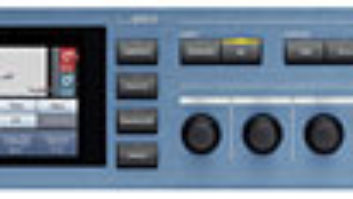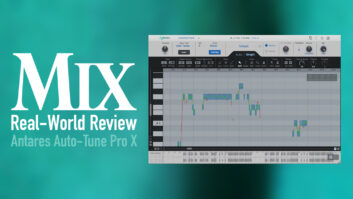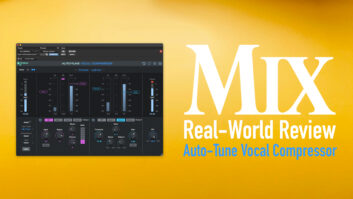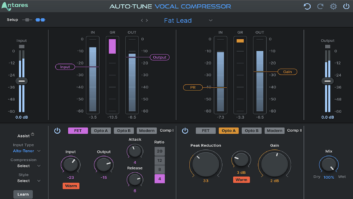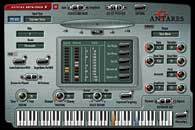
Auto-Tune’s virtual keyboard lets users set pitch-correction parameters.
The world’s most ubiquitous pitch repair tool just got better. Antares Auto-Tune 4 retains all of the great things you can do — or overdo — with past software versions, while adding a vastly improved user interface, 192kHz capability, a more musical vibrato and more. The tried-and-true ways of setting up the interface, including key and scale choice, input type, retune and tracking, are still the way all users should handle the interface. However, Antares has added new toys that make the interface much more fun and musical.
SO WHAT’S NEW?
Starting with the simplest changes, the Options box now offers selectable graphics colors. This is in response to color-blind users (true story) who had trouble viewing the default colors in past versions. Next, A-T 4 gives you the option of altering the behavior of the knobs. Do you prefer a vertical, horizontal or radial mouse stroke to change parameters? No problem — it’s just an option away. The Custom Cursors option lets users turn cursor shapes on or off in the Pitch Graph display in Graphical mode. The last new option, and a very welcome one, is the ability to choose up to 20 levels of undo.
AUTO MODE ENHANCEMENTS
Auto mode now offers a virtual keyboard (a blast from the past) that allows the user to be extremely selective about what does and does not get pitch-corrected. You can set the keyboard to choose the note in all octaves or just the notes you “play.” Notes can also be set via MIDI; the onscreen keyboard reacts as notes are played.
The Vibrato mode adds a lot of new functionality. The depth, rate and delay options of old are replaced by rate, variation, onset delay, onset rate, pitch, amplitude and formant. Variation adds a random character, and onset delay sets the amount of time between the beginning of the note and the start of the vibrato. Onset rate sets the amount of time between the end of the onset delay and the point at which the vibrato reaches the full amounts set in the pitch, amplitude and formant settings. Pitch and amplitude control the amount of pitch and amplitude variation in the vibrato. Lastly, formant sets how the timbre of the vibrato changes as it develops.
The mysterious Improved Targeting button uses the theory of Stochastic Optimal Linear Estimation (whew!) to help Auto-Tune 4 differentiate between vibrato and intentional pitch change. In the center section, there are now Set All, Remove All and Bypass All buttons that make for quick note-selects and deselects. Lastly, just under the meter is a Hold button that lets you freeze the meter in time to check exactly how much pitch change is taking place.
STREAMLINED GRAPHICAL MODE
The Pitch Graph display has increased a whopping 22 percent and new streamlined navigational controls make it much easier to get your audio sample centered while working. There are new cursor picture displays at the top of the window and some welcome new tools. The Scissors tool allows you to go in and snip out a section of the sample for special treatment, while the Magnifier and Hand tools make it much easier to blow up and move the window within the interface. Vibrato scaling increases or decreases the amount of an existing vibrato while preserving its original shape and character.
THE EARS HAVE IT
I tried Auto-Tune 4 on a variety of sources, both vocal and instrumental, with great results. The Vibrato mode is much improved and more random, with the Formant option definitely making it more believable. Improved targeting is a nice addition and, as with all parameters in Auto-Tune 4, it seems to work better on some sources than others. What I like most about A-T 4 is that you have to use your ears.
The most apparent improvement in A-T 4 is the interface. In past versions, Graphical mode has always been less than intuitive; this is no longer the case. The navigation is much more flexible and the bigger size makes microtweaking a more pleasant task. The layout and new tools make for improved workflow, and the ability to reverse tasks through multiple layers of undo makes me wonder how I ever got along without it.
The virtual keyboard, and its ability to isolate pitches targeted for correction, is a wonderful addition. It makes Auto mode a breeze to use and the outcome much more musical. The ability to isolate notes as played, or in all octaves, is brilliant.
THE FIX(ER) IS IN
It’s clear that Antares has been listening to its users and watching its competition. From the changeable graphics colors to the expanded vibrato options, added tools, variable knob controls and streamlined navigational controls, Auto-Tune 4 is vastly improved. The term “clunky” no longer applies — especially in reference to the Graphical mode. The manual is very well done and highly recommended reading. Even though the UI has risen to a new level of user-friendliness, it’s nice to know what some of the more mysterious parameters actually do.
For anyone using pitch correction in production (is anyone not?) or wanting to create the next pitch-based effect, Auto-Tune 4 is a must-have upgrade. Prices: OS 9/OS X (TDM), $599; (MAS/RTAS/VST), $399; and PC (RTAS/DirectX), $399. Various upgrade paths are available.
Antares, 831/461-7800, www.antarestech.com.
Kevin Becka is a closet auto-tuner and technical editor of Mix.
